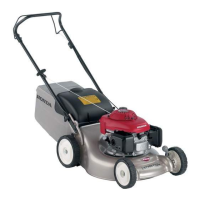10-11
dummyheaddummyhead
CRANKSHAFT/PISTON/VALVES
CYLINDER COMPRESSION CHECK
Start the engine and warm up to normal operating
temperature.
Turn the fuel valve to the OFF position, and then drain
the carburetor.
Remove the spark plug cap and the spark plug (page 3-
4).
Pull the recoil starter several times to expel unburned
gas.
Attach a commercially available compression gauge [1]
to the spark plug hole.
Pull the recoil starter forcefully to measure stable
cylinder compression.
CRANKSHAFT RUNOUT CHECK
When checking the crankshaft runout, do not allow the
dial indicator tip to drop into the keyway.
Use the bolt [1] to rotate the crankshaft.
Record the runout.
If the crankshaft runout exceeds the service limit,
replace the crankshaft (page 10-7).
Gasoline is highly flammable and explosive. You
can be burned or seriously injured when handling
fuel.
• Keep heat, sparks and flame away.
• Handle fuel only outdoors.
• Wipe up spills immediately.
CYLINDER COMPRESSION:
0.45 MPa (4.6 kgf/cm
2
, 65 psi) / 600 min
-1
(rpm)
CRANKSHAFT RUNOUT: 0.20 mm (0.008 in)

